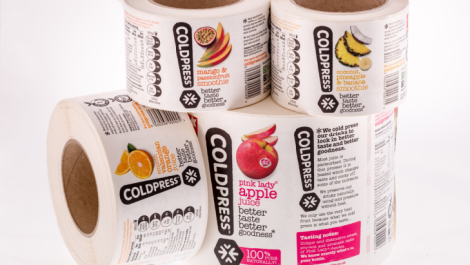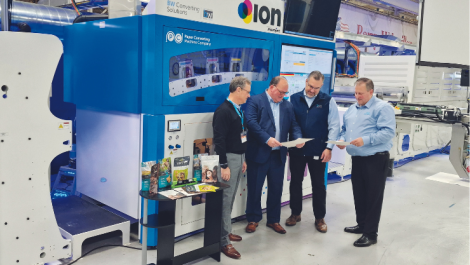Findings from the first of a new series of industry reports reveal that whilst digital is well-known I narrow web labels, it is far from a mature market with the entire supply chain continuing to find new and innovative ways to deploy inkjet and toner-based technologies. Report authors Kevin Karstedt, Jeff Wettersten and Jean Lloyd present some of the highlights
Keypoint Intelligence’s State of the Industry is a five-part report series, using quantitative and qualitative data to review the state of the print industry as it relates to the adoption and use of production digital presses. Reports are to cover the narrow web label, corrugated, folding carton and flexible packaging segments. The series is to conclude with in-depth analysis and feedback from brands regarding their current and future use of digital printing.
The recently published State of the Industry Report: Narrow Web Labels acknowledges that the use of digital to produce narrow web labels has a long and varied history spanning almost three decades. From the adoption of toner-based presses in the early days to the more recent rise in inkjet and an expected explosion in hybrid machines, the number of narrow web digital label presses installed has grown steadily since the early 2000s. This has led some OEMs, suppliers and converters to wrongly assume that the market has reached a position of maturity. This, in fact, could not be further from the truth, with almost three-quarters of those interviewed still viewing digital as ‘disruptive and transformational’. Our research has indicated that not only are technological advances going to expand the role of such hardware in converters’ businesses, digital is going to open up new and as-yet untapped applications.
Digital printing enjoys a position of strategic importance to many converters and factors heavily into annual review processes. Technology improvements, supported by improved software and converting capabilities, are expanding the touchpoints of digital’s participation in converters’ businesses. This includes as a standalone production tool as well as a complement to analogue systems that allow converters to better balance their production and maximise asset utilisation. Specifically, digital assets are enabling real-time ‘factory in a factory’ capabilities that are driving improvements in plant productivity.
Converters are leveraging all of the above to secure new business. This is evidenced in the fact that the volumes produced using digital are expected to grow at a rate that is more than a third higher than the overall industry growth rate over the next 10 years. In the near future, those interviewed for this study expect their installed base of digital printers to increase 51% through to 2027, while the output of volume produced on their digital assets is projected to increase 68% at the same time.
Whilst some of this growth can be accounted for through work being transitioned from analogue assets over to digital, there are also specific markets emerging with demands best served and even requiring production on a digital press. The demand stream spans service as well as product attributes, and covers: superior print quality and colour consistency over flexo; a faster time to market; ability to promptly modify and update labels; variable data capabilities; the option to conduct test marketing using smaller volumes; SKU proliferation and diversity; and low or no minimum order quantities (MOQs).
Trending topics
There are some key trends identified and addressed by the interviewees. Of note are business improvement, consumer engagement and sustainability.
In terms of business improvement, technological advances, production efficiency and operational excellence are highlighted as things converters must embrace to thrive. A mix of technologies will prove most beneficial in the long run, whilst converters must also decide if and where online/web-to-print works for them. Also, those that invest in automation and robotics will flourish in the medium to long term. Overall, businesses must be flexible and adaptable. Investments will be central to this, as serving brands with better technologies will result in more satisfied customers.
When it comes to customer engagement, as more brands continue to seek visibility across their supply chains RFID technology adoption will offer exciting possibilities at every step of the value chain. Artificial intelligence (AI), the Internet of Things (IoT), augmented reality (AR) and virtual reality (VR) are also slowly making their way into the print industry, changing the way label converters must manage their businesses and the products they need to be able to offer to brands and consumers.
The environment and sustainability is another topic that has and continues to shape the industry’s thinking. Having said that, whilst on the supplier side sustainability made everyone’s list for the top initiatives of 2023, for converters it was not identified as a high priority. There are a few factors that are likely driving this disconnect, such as that supplier development timelines require converters to investigate and develop for the future – typically five years into the future. Converters’ answers reflect their development pipeline, which is typically aligned with capital investment budgets two to three years into the future. In addition, for those in Europe, they have a different mindset and urgency regarding sustainability due to passed legislation, as compared to Asia and North America where laws are being discussed but nothing is set in stone, as yet (making it important for converters operating in such regions to get ahead of the sustainability curve by creating options).
Conclusion
Taking into account all that we’ve spoken about and heard during the course of this exhaustive research project, the following takeaways can be gleaned:
- There are opportunities for OEMs to gain converters’ favour;
- Application development is welcomed, whilst brand engagement and education on digital printing will help, especially for smaller brands;
- Analytical tools are very much appreciated and needed; and
- More creative financing techniques should be introduced to help converters invest more readily.
- Moreover, the incumbency of a current supplier is primarily driven by quality of support, services and training – and not necessarily features. If the next purchase is primarily driven by new features, suppliers that are incumbent as well as new must have the desired features to be considered by the converter.
Software and workflow are major areas of investment, mostly driven by the need for automation and efficiency improvements to reduce labour and time. Key priorities here include automated order processing and management, ERP integration and workflow automation, as well as analytics and uptime management. Despite this importance, for many converters software is a mystery. Suppliers must work on making new software easily understood by showing the converter this is what you do today, this is what you will do in the future. Key things to address are what changes, how does It change and what is the value of the change?
This is an overview of the new State of the Industry Report: Labels, as published by Keypoint Intelligence; visit here for more






